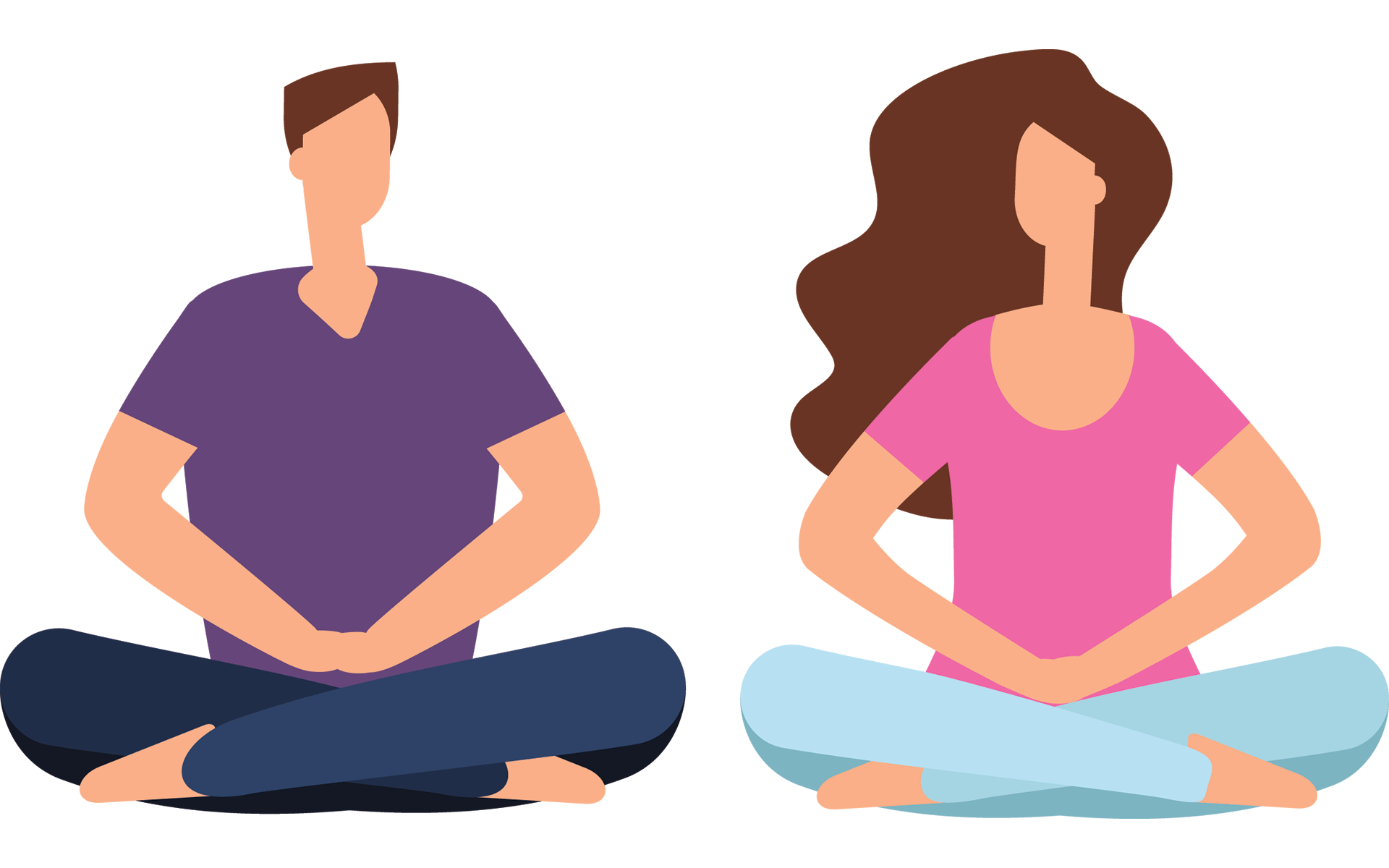This Three-Minute Morning Mindfulness practice is one of three Renegade Rituals for holistic well-being as described by Pilar Gerasimo in her book, The Healthy Deviant: A Rule-Breaker’s Guide to Being Healthy In an Unhealthy World (2020, North Atlantic Books).
I developed my Morning Minutes ritual by co-opting an idea from my younger sister, Andrea, a yoga teacher. Many years ago, having recently gotten her five-hundred-hour yoga-instructor certification from Kripalu, she had committed herself to doing thirty minutes of yoga each morning. It was an ambitious goal, so within a week or two, she found she was struggling (and often failing) to make that commitment work in the context of her daily life.

So instead of continuing to struggle or simply giving up, she radically redesigned the scope of her commitment. Her new plan was to simply unroll her mat, light some incense, kneel, and calmly taking three deep breaths. From there, she had the option of doing as much or as little yoga as she chose.
Of course, once she got to her mat, smelled the incense, settled in, and took her first breath, she often felt like stretching into a few asanas. From there, she might feel inspired to spend significantly more time on the mat, sometimes exceeding her original thirty-minute goal.
For me, the central appeal and core value of the practice lay in simply taking the first few minutes of the day for myself. So I expanded the range of potential practice activities to include anything calm, peaceful and pleasurable.
Envying both the beautiful experience my sister was giving herself, and the results she was getting, I tried copying her technique for a while. Over time, though, I realized that on some mornings, I didn’t really want to do yoga. I was called to journal or meditate or play my guitar instead.
For me, the central appeal and core value of the practice lay in simply taking the first few minutes of the day for myself. So I expanded the range of potential practice activities to include anything calm, peaceful and pleasurable that happened to appeal to me on that particular day.
I decided my minimum daily commitment would be three minutes, and I’ve been doing it ever since—sometimes for an hour or longer. On the rare days when I miss my Morning Minutes practice, I feel the difference, and I’m inspired to return to it, pronto. So, don’t be shy about improvising with your own three-minute ritual.
Waking Up to a Better Day
Do you know how most Americans wake up? They jolt awake to an alarm, flip on bright lights, reach for their electronic devices, then dive directly into their day’s activities and responsibilities. They check email and texts, scan social feeds and news headlines to see what they might have missed while they slept. Seconds after their feet hit the floor, they switch on the television or radio to hear the familiar prattle of morning-show hosts or the dire pronouncements of news anchors; they turn on loud, hyper-intense music or hop on treadmills to get their blood pumping. Others jump into productive tasks, returning emails and calls, responding to requests for information, finishing up last minute assignments before they have to go to work.
For your sanity, for your health, and for the benefit of everything you hold dear, you are going to consciously reclaim the first few moments of your day—for you. Rather than abruptly throwing some big industrial on-off lever into the on position, you’re going to turn your delicate dials at a pace your body and brain can handle. And for that, you will be richly rewarded, because from here on out, every single part of your day is going to go better.
The Three-Minute Morning Ritual
Waking more gently lets you take advantage of important theta-brainwave states and ramp up more gradually toward demanding tasks. Regularly adhering to a simple morning ritual also helps you build self-efficacy, develop mindfulness and equanimity, and prepare for a successful day. It lets you start the day on your own terms. So let’s do this thing!
How to Start:
- First thing on rising, before you do anything else (especially looking at your phone), choose any feel-good activity and just enjoy it for at least three minutes, or for as long as you find it rewarding and doable.
- Before and during your Morning Minutes practice, avoid all exposure to electronics, media, and other sensory distractions or stressors. No email, texts, social media, or news until your body and mind have had a chance to come gradually and peacefully into their relaxed waking state.
- Some good Morning Minutes practice options include meditation, yoga, stretching, reading poetry or wisdom literature, journaling, stepping outside to see the sunrise, listening to birds through an open window, or playing a musical instrument.
- Consider using the last few moments of your practice to set your intentions for the day and visualize how you want it to go or to reflect on the things you are most grateful for.
- Close your practice with three deep, energizing breaths. Then move on to the active part of your day, noticing how the three minutes you just invested in your own well-being changes your outlook and energy.
Why:
- This lets you preserve and take advantage of the valuable “twilight” theta-brainwave state that exists between waking and sleeping—a highly suggestible state associated with insight, creativity, healing, lucidity, and deep awareness.
- It reduces the alarm response of the sympathetic nervous system and associated inflammatory cortisol spike.
- It spares you from exposing your mind to stressful, distracting inputs and outside agendas when it is at its most impressionable.
- It builds your capacity for self-regulation and your sense of self efficacy (the belief that you can do what you set out to do).
- It empowers you to start your day on your own terms (rather than in reaction to outside forces).
- It builds your “savoring” muscles—helping you develop the neurocircuitry for experiencing and registering positive, pleasurable experiences and harvesting the downstream dopamine rewards (see research by Eric Garland, PhD, on how savoring works to counter unhealthy addictive tendencies).
- It establishes an early state of mindfulness and equanimity, making it easier to retain and reclaim that state later in the day.
- It gives you an early window of opportunity to establish your autonomy and to carry that sense of sovereignty with you as you go out to face the day.
- Notice barriers and attitudes that may be undoing other healthy intentions.
Tips for Waking Up:
- Wake to a pleasant, non-jarring signal or sound, ideally from something that is not your smartphone. I prefer Now & Zen’s progressive chime-based alarm clocks and light-based, sunrise-mimicking alarm clocks (like Philips Wake-Up Light, Lumie Bodyclock Active Wakeup Light, and MOSHE Sunrise Alarm Clock), most of which also have audible-alarm backups), but low-key, wake-to-music options can work, too—just be sure you can easily turn off, turn over, cover up, or otherwise block any light-emitting displays.
- Keeping houselights low, if possible, go directly to your practice area. If you’re a person who loves coffee, hot tea, or water first thing, feel free to make your preferred morning beverage to enjoy during your practice.
- Avoid all interaction with complex electronics, digital devices, media (including radio, television, and newspapers)—and ideally, any complex interactions with other people—until your Morning Minutes practice is complete.
- Set a timer for a minimum of three minutes, take a breath, and settle yourself.
- Choose any feel-good activity (see list of suggestions below) and enjoy it for the period of time you have chosen, or for as long as desirable or doable.
- On closing, do a brief ideal-day “snapshot” visualization or set intention for the day—or just take three deep breaths—and blow out the candle.
- Notice how you did (or did not do) the practice.
- Track immediate and longer-term effects.
Optional Morning Minutes Activities:
What you do during your Morning Minutes window is entirely up to you. What’s important is that you do it for a minimum of three blissful minutes.
- Meditate, pray, or do breathing exercises.
- Do yoga, stretch, foam-roller, or massage your hands and feet.
- Step outside, look at the sky, and listen to the birds or the sound of the wind.
- Pet your dog or cat.
- Play a musical instrument.
- Doodle in a sketchbook.
- Write a little poem or pen a love note to yourself or someone else.
- Envision one thing you’d like to see happen today.
- Think about three things you’re grateful for, taking one deep breath for each.
- Just sit there, do nothing, and notice how that feels.
Remember, your minimum commitment for this practice is three minutes. You can go longer if you like (hey, if you can carve out the time, take a half hour or more!), but let three minutes be your base plan. Even at three minutes, you might be tempted to skip this apparently self-indulgent and unproductive practice. After all, you’ve got things to do! You are busy and important! People are relying on you!
The path starts right here with this small, seemingly innocuous yet revolutionary act. This is your moment.
All the more reason why this three minutes matters so mightily. How much will everyone in your world benefit from a saner and stronger you? Plenty. Keep in mind that this is how you reclaim your power to choose. This is how you train your system to do something beyond the habitual and out of the ordinary.
You’re going to be doing a lot of that down the road. But the path starts right here with this small, seemingly innocuous yet revolutionary act. This is your moment.
So enjoy. For three whole minutes.
Reflection:
Did you do your Three-Minute Morning Ritual? Yes? Great! How did it feel? Did you not do it? Hmmm, interesting … notice why. Write down the reason.
Remember—the goal is not for you to comply with any one set of steps or parameters that I prescribe; it’s for you to establish healthy patterns you can enjoy for a lifetime. This simple, quiet, three-minute space is where all of your new patterns take root.
Excerpted from The Healthy Deviant by Pilar Gerasimo. Published by North Atlantic Books, © 2020 by Pilar Gerasimo. Reprinted with permission of publisher.
read more
Mindfulness Meditation: How to Do It
Mindfulness meditation practice couldn’t be simpler: take a good seat, pay attention to the breath, and when your attention wanders, return. Read More
How Mindfulness Helps You Find Time
By taking simple, mindful breaks, we can become more aware of our thoughts, emotions, and habits, which brings the clarity we need in order to choose how we spend our days. Read More










